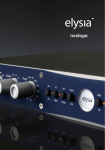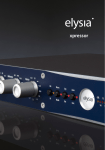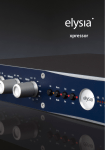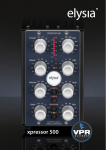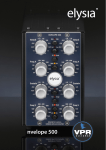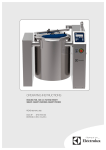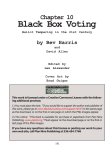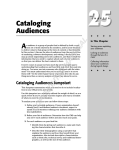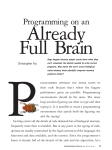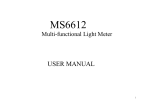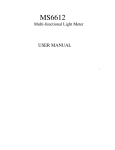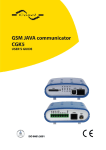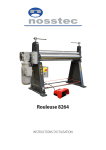Download this review
Transcript
The Miracle Machine TEST AUDIO HARDWARE “The elysia alpha compressor is an extremely well-built unit, made for one special purpose: F TEXT: JÖRGEN CREMONESE or one year the internet has been talking about the first product by elysia, a completely analog compressor that was consequently named alpha. What we already know in the run-up to the review is that we are talking about a complex and with a net retail price of 7.990 Euro [Germany] pretty high-priced piece of equipment. For a couple of days I have been sitting here together with producer Charlie Storm, trying to understand the elysia alpha in all its potentials. And we are lost for words indeed. The elysia alpha compressor is an incredible unit – no, let me put it another way: it almost appears menacing! Outward appearance With its sixteen kilos of weight, its rugged and extremely solid housing and a total of forty-five knobs and controllers on the front, the alpha almost seems to exclaim that I have overreached myself! Now my facade is about to crumble; now it will become obvious that I am just a charlatan… But then curiosity wins. What can I use the alpha compressor for? After immersing in the well written user manual for fifteen minutes I have already understood enough that I think I am able to start. Have a look at the picture: On each side there is a compressor section, a filter section and a mix section. That is in fact pretty easy and clearly arranged. The manual explains the conception of the unit and describes a lot of practical examples of use. As a conclusion to the plain and educationally well written text I find the AC/DC quotation “Let there be sound! And there was sound.” Striking! What am I supposed to believe after all? A stunning sight I place the solid alpha on top of a rack and try to dissemble its serious weight, and then I connect it to the HD3 system and to the mains supply. That is easy, as there are only two inputs and two outputs plus the mains connector on the rear panel. Well, there is something else: Two rotary discs for adjusting the contrast of the controller illumination. I switch the alpha on and hear a short sound of relays clicking, then I see a couple of lights flickering. I bend down and see how the alpha lights up – almost like an encounter of the third kind with an alien mother ship. Unbelievable! I start with regulating the contrast of the controllers; the range of brightness goes from subtle to causing migraine. But whatever I do next, I don’t hear a single sound. No clicks, no hum, nothing. And the controllers are obviously of the highest quality. Using them is uniquely comfortable, as they lock in their positions as if they were slightly suspended. You can’t do anything wrong here, like changing one of your settings by mistake. As already mentioned, each channel is divided into three sections. The great lot of information assailing you at first sight is overwhelming indeed. Therefore it is time to take a deep breath and approach the elysia alpha step by step. We load a finished mix by Eric Ramsey (the “indiepostrock-electronica-folk-psychedelic” artist) in order to start checking what we can do with this compressor. No influence on phase The first test consists of applying some simple stereo compression. We use the compressor section (top), the gain controller (bottom) for the make up gain and the stereo ELYSIA ALPHA to be the best and most sophisticated compressor in state-of-the-art technology!” Elysia – a place that was struck by lightning, where strange powers rule and the forces of nature are suspended. The ancient Greeks described elysia as a place providing body and soul with creative strength and helping philosophers, politicians, rhetoricians, athletes and especially musicians and artists to create something extraordinary. Therefore it was a pretty clever decision of Dominik Klaßen and Ruben Tilgner to choose this name for their new company dedicated to the production of audio equipment without any compromise. The Swedish distributor Golden Age Music in Alingsås told us we were probably the first magazine to get hold of an alpha compressor… and we at Monitor want to test it, of course! link mode. Now the left channel functions as a master for both sides, but I have to set the gain for each channel and activate them separately by pressing both Compressed knobs. That all seems very easy and logical – maybe the alpha is not so dangerous after all? I start the track with the alpha’s control functions in zero position so that it does not produce any compression at all. Then I activate the compressor (“non active” mode means a hard bypass, by the way) in order to find out if the unit produces any noise. No, no, there is absolutely nothing! And the phases of the audio material sent through it show no signs of being influenced at all. Indeed, I did not find any phase shifts in stereo mode before starting to turn the controllers. The first song I use consists of an acoustic guitar, a mellow girl’s voice and a chorus with a deep, almost floating bass. At the end there are some additional samples that run criss-cross through the complete frequency range. This is everything but a simple task, because the dynamics of the track show extreme variations. But I just start and set the attack to a very slow time (150 ms) and the release to its fastest value. Then I set the ratio by ear (ap- prox. 1:1.5) and the threshold to -3 dB. Our alpha reacts at once, and the big central LED meter starts to light up. The meter takes half dB steps up to -3 dB, full dB steps up to -6 dB, 1.5 dB steps up to 11 dB and finally 2 dB steps up to 20 dB. The main material of the track is compressed by 1.5 dB, whereas the peaks are reduced by 3 dB. I compensate this with the make-up gain and chose the same level the original material has. Now I make the A/B comparison. Hard bypass it was, wasn’t it? Anyway, let’s check the results. What does it sound like? The first thing that I subjectively notice is that the guitar gains in body and depth. The main reverb – an EMT 240 – gets an incredibly realistic color of sound and appears much better defined than before. Now I raise the ratio value a little bit (1:1.7) and set the threshold to -5 dB. The controllers snap in at every half dB, and the light of the controller is guided by a cut-out in its jacket in a way that it projects a precise mark onto the scale. This shows the exact value unmistakably. With the alpha, everything is clearly and precisely defined – and this concerns its construction and its quality of audio processing in equal measure. TECHNICAL DATA Frequency response: <10 Hz - 200 kHz (-0.5 dB!!!) THD+N @ +15 dBu, 20 Hz - 22 kHz: Stereo mode (Direct): 0.0039 %, Stereo mode (Compressed): 0.009 %, M/S mode (Direct): 0.014 %, M/S mode (Compressed): 0.034 % Noise floor, 20 Hz - 20 kHz (A-weighted): Stereo mode (Direct): -95.8 dBu, Stereo mode (Compressed): -89.3 dBu, M/S mode (Direct): -95.6 dBu, M/S mode (Compressed): -92.3 dBu Dynamic range, 20 Hz - 22 kHz: Stereo mode: 122 dB, M/S mode: 118 dB Maximum input level: Stereo mode: +28 dBu, M/S mode: +23 dBu Maximum output level: Stereo mode: +27 dBu, M/S mode: +28 dBu Input impedance: 10 kOhm Output impedance: 68 Ohm Dimensions: 483 x 133 x 405 mm Weight: 16 kg Price: 7.990 Euro net [Germany] Manufacturer: elysia GmbH, Nettetal, Germany www.elysia.com TEST AUDIO HARDWARE The Miracle Machine „The first thing that I subjectively notice is that the guitar gains in body and depth.“ M/S matrix The next track has a completely different character: it is a kind of drawing and pumping machine drum loop, combined with a natural drum set with a shuffle pop beat plus synchronized vocals with a compact choir in the chorus. All in all, this material can only be described as an organized chaos which sounds so massive that I really start wondering if there is any space left at all to actually do something with it? I decide to test M/S processing for this task. By doing so, I can split the material into a mid band (mono) and a side band (left plus right minus the mono information). The left channel of the alpha now controls the mid band, while the right channel is responsible for the side information. If one had never worked with the M/S technique, this all could easily leave the impression of Science Fiction. And indeed, at the beginning I cannot get rid of the feeling to be led up the garden path. But then I remember to consult the excellent and educationally well written manual, and instantly there is a feeling of hope. The actions to use this feature for the wanted application are easy: Deactivate the channel link, activate both Compression switches in the mix section, engage the M/S mode, and that’s it! The track is compact, but now I get the feeling that the mid still has some space available: in the middle frequencies for letting the vocals appear more clearly as well as in the bass region in order to give these transients more power. I use the audio filter to achieve more clarity around 4 kHz and boost this frequency area, which simultaneously results in a reduction of the lower frequencies. This leads to an audible shift in the tonal balance. Both of us (the producer and I) are equally stunned about how significantly the overall sound character can be changed with such small alterations. Even if you know what you are doing very well, you have to take care to use this feature sensitively. Therefore, the filter gain can be applied in well controllable steps. As you can see in the picture, there are 0.3 dB steps from 0 to 2.7 dB and Hi/Lo. The sidechain filter to the right works a little bit differently: Here you can choose which frequencies should have a stronger or weaker influence on the compression process. In the extreme settings (LP and HP), this filter works as a low pass or a high pass respectively, both with 6 dB and a boost/cut resolution of 0.3 dB per step. Abstract? Yes, maybe a little bit, but I just continue with the track and give the transients mentioned above a little bit more saturation and check the result with the bypass function. I instantly notice that within just a few minutes I was able to give the audio material a better definition and more saturation, while – attention – reading the manual at the same time. Now I raise the amount of compression and reduce the attack a little bit. Now it really sounds like it is supposed to. Deep below are the bass frequencies, nicely separated from each other, and the vocals appear clearly and well defined. A TRUE GEM... I am really staggered by two things: What the alpha does with the audio material, and how easy the workflow is! To say it a little bit more clearly – the track has gotten the touch of a finished product within only five minutes! What sounded good and dynamical has changed in a subtle and uniquely defined way and has gained in depth as well. But neither the producer Storm, who has been working with this material for several weeks, or I can really tell where exactly this difference lies. We instantly burn a stereo file of the compressed song on CD and get back to work. Now I reset all settings back to zero and just send the track through the alpha without any compression at all. I switch off the Active button, and things just sound exactly the same! I ask Storm to switch the unit on and off without me knowing what the current status is, and after only five seconds I have already lost my orientation. Now we can definitively say that the alpha does not influence the material in zero position or in bypass mode. It seems like a miracle, but on the other hand this is just what you would expect for 7.990 Euro, isn’t it? ELYSIA ALPHA Transformer With the intention of making everything tighter I now activate the transformer feature. This has got nothing to do with the usual input or output transformers, but – and I find this very interesting – switches an additional transformer into the signal path to turn the sound of the alpha compressor a little bit more into the direction of a classical compressor. I push the button and notice that this is not just a small step into the right direction, but just what I needed to give the material in the mid channel its final polishing. The lowest frequencies are nicely rounded and get a touch of tape compression – they swing beautifully and have just the right bite in all the important transients throughout the complete frequency range: 80 - 100 Hz for the bass, around 200 Hz for the drum rolls, 1 kHz for the rest, approximately 3 - 4 kHz for the vocals and 8 kHz for the attack. And the higher frequencies, far, far in the upper regions and surely beyond 20 kHz (where those things happen that are rather sensed than actually heard) give the complete package somehow more “air”. Now the mid channel seems to be finished for now. Next, I switch off the mid channel by deactivating both its Direct and Compressed buttons. Now I only listen to the side channel, and it is really a strange feeling to hear only what is going on in the sides. And: We can directly hear that the bass is somehow “polluting the area”; something that we definitively do not want. On top of this, we hear a humming sound of a strange repeating interference that reaches far down into the lower frequencies. Probably this comes from a synthesizer located in the same area like the drums. We filter the complete side signal with 2 dB at around 500 Hz, and the side material instantly starts to shine! We do not apply a lot of compression and activate the Auto Fast function for both attack and release. Then we also activate the transformer, resulting in additional stability, and spice the result with the audio filter which is set to only 0.3 dB at 3 kHz. Now the side material sounds just as we wanted it to. Hard to describe, but really good! We have achieved a good and compact compression that preserves the higher guitar tones as well as the sparkle of the reverb as well as the deep synthesizers and samples. Now I adjust different levels for the mid and the side channels – this is also possible after all – in order to achieve just the balance between the mid and the side material I had in mind. Everything is possible: turn down the bass, or turn it up, the same with the drums, or the vocals… We mix the material (mid and side) and check it with the bypass function. Did we ruin the track now? Did we want too much, so that the phases are not optimal anymore? No, of course not! Only the following happened: We made the bass and the drums denser without any negative side effects in the lower frequencies. Then we gave a clearer definition the middle and the high frequencies without making it sound too sharp. And we also applied a soft compression in the side channel that lets the attack of the guitars pass nicely and gives the reverb a beautiful, clean flow which makes it fill the room sweetly. Everything came out just as we had intended. The melody and rhythm information in the mid channel gained in stability, and I could rise the mid a little bit while making the sides more concise at the same time. Then I applied a little bit more compression with just a minimal increase of level. And I did all that in only ten minutes! Without ever having done something similar or having worked with the elysia alpha compressor before! I am truly impressed! In my virtual purse, a growing love for the alpha seems to start wrestling with fears of loss. But slowly, the awareness that I could get over 7.990 Euro in consideration of the functionality we have experienced within just one hour, including coffee and cake, gets the upper hand! TEST AUDIO HARDWARE The Miracle Machine After that, I get back to playing around with our Eric Ramsey material. I do not need much more than fifteen minutes per song for processing four further tracks. Every song is about four to five minutes long, so I have to listen to the whole thing just three times. The work of the first night is finished, and on my way home I keep furrowing my brow: How can I make it to raise nearly eight thousand? Maybe I should offer my body for scientific experiments? More practical experiences On the next evening, we (the author himself and the producer Storm) concentrate on our next task with great enthusiasm: the new album from maestro Gunnar Danielsson. The state of the files we received was everything but good. They had been recorded with Logic Express – obviously with lots of love, but everything else left a lot to be desired. The songs sounded as if they had been recorded in a cardboard box throughout. On top of that, all tracks had been sent through a Sonic Maximizer plugin which scrunched the material forcibly – obviously following the one-for-all approach… We are not amused at all and try to create sound files without any master plugins, but in the end we have to accept that we have to use what is there. Ok, now it is time for the alpha to show its colors. And we are pressed for time: All in all, twelve tracks must be souped up – in the evening, after my regular working time, and that as fast as possible, because I have to give the alpha back very soon! This almost asks for military discipline, otherwise I cannot be done. We divide the tracks according to their dynamics – chill-out, soft pop and compact material – in order to create three “presets” we can work with. We start our work with the smooth tracks. The arrangement of the instruments is not very complex, but it suffers from being totally two-dimensional and also from very diffuse vocals. Again we decide to work in the M/S mode. Here, this function can really show what it is good for. First of all, we have to start with clearing things up and – if possible – bringing the melody and rhythm to the fore in order to make the songs work. We play the first track and disable the side channel. Now we can instantly hear what is missing: The bass in the mid channel is deeper than in the side channel, and the vocals have either been manipulated heavily or recorded in such a wrong way that they sound extremely diffuse. Alright, this calls for “heavy equipment – but I am sure we can make it! Our first move is to try giving the mid a better definition. Therefore, we use the audio filter in order to enhance the vocals. Without encountering any problems we raise the complete material above 3 kHz by 2.5 dB! Now the vocals sound much better, and also the definition of the drums has improved. We prepare to apply some compression by setting the sidechain EQ to a low pass at 200 Hz in order to tighten up the bass frequencies. Then we activate the Auto Fast function for both attack and release and apply a pretty strong amount of compression with a ratio of 1:8 and the threshold at -10 dB. Now the track has a completely different character in terms of sound and information as well. I try the feed forward mode that switches the tap for the sidechain before the compression module, but here the effect becomes too strong and affects the vocals. So I go back to feedback mode. I compensate some gain; make a slight change in the balance between the direct and compressed signals – and I am done! Clearing the space In our demo production, the side areas are filled with bass frequencies that are literally just “lying around” without any use; also they have too much pressure because of the Sonic Maximizer plugin which messes everything up more than ever. It is almost strange that we still manage to find some space to work with in these files! This credit can only go to elysia – without the slightest doubt! So we start tidying up the lower frequency region and apply a soft compression with a slow attack and the release supported by the Auto Fast function. The result is that the frequencies above 1 kHz gain in stability and definition, and the next thing we notice is that – as if by magic – we are already finished! Now we combine the mid and the side channel. Especially in this application we notice that the possibility of setting the levels for both channels independently is an invaluable asset. We manage to bring out the vocals, add some nice saturation to the drums and free some exciting sounds from their straightjacket! The difference between the original and the material processed with the alpha compressor is really big. In effect, it is amazing. We approach the remaining tracks of our project the same way: We clean up, add a little bass, change the balance between mid and side, compress the mid quite strongly – and still the material coming out of the alpha compressor sounds less squashed than the original! How can all this be?! M/S MATRIX What can actually be done with the M/S processing mode of the alpha compressor? Most of us don’t even know what that is – and does it make any sense at all!? We will talk about this now, but not before pointing out that the alpha is a completely analog tool. There are absolutely no internal AD/DA converters. The possibility to split the audio material into a mid channel (where usually the most important rhythmic and melodic information is placed) and a side channel (where the special effects, the “filling material” and the guitars can be found) cannot be valued high enough. I plainly switch the side channel off by deactivating its Direct and Compressed buttons, which generates a signal that consists only of the mid information. Now I notice clearly that I can optimize the material by using the audio filter. It gives you two frequency ranges to work with: 20 Hz - 2 kHz and 200 - 20 kHz (the latter being chosen by activating the x10 knob). The filter works with a selectable center frequency. Now you can cut or boost up to three dB, which seems to be not very much at first sight, but in reality it already makes a difference of six dB. This is because the filter boosts the bass and cuts the treble related to the center frequency at the same time or just the other way round. Complicated? Well, if I have to admit that if you just read this it really seems to be a little bit abstract, but when you activate this filter, you will directly understand what it does! Conclusion Oh yes, this is the central question of this review! How can it do this… and that… and that!? The answer lies in the fact that the elysia alpha compressor is an extremely well-built unit, made for one special purpose: to be the best and most sophisticated compressor in state-of-theart technology! If you look at the alpha only halfheartedly, you might become of the opinion that the price is quite high after all. But you should not make this mistake by all means! Maybe the market for this unit is not very big, but nevertheless I am sure that in the introduction phase at least ten of these units should change hands. Max Martin must have one, Murlyn Music must have one, Michael Ilbert has got to have one, Benny Andersson also needs and Per Gessle must give one to Christoffer as a present… and so on! Uniting all these diverse functions in one unit is simply a stroke of genius, and keeping everything clearly arranged and making it easy to use makes it a complete miracle. Never before was I able to work with such a complex unit like the alpha compressor, and I will not miss even the slightest chance to rent it for my work. The fee I will receive for this article will hopefully be enough to pay for a day’s lease, and then I could… PS: At the end of the day I actually also recorded drums with two microphones and drove both channels directly via the alpha compressor into the DAW. Then, I routed both channels on a buss and compressed them again. Nothing vanished; everything just got clearer, more solid and defined! Well, an expensive drum compressor, but anyway…






